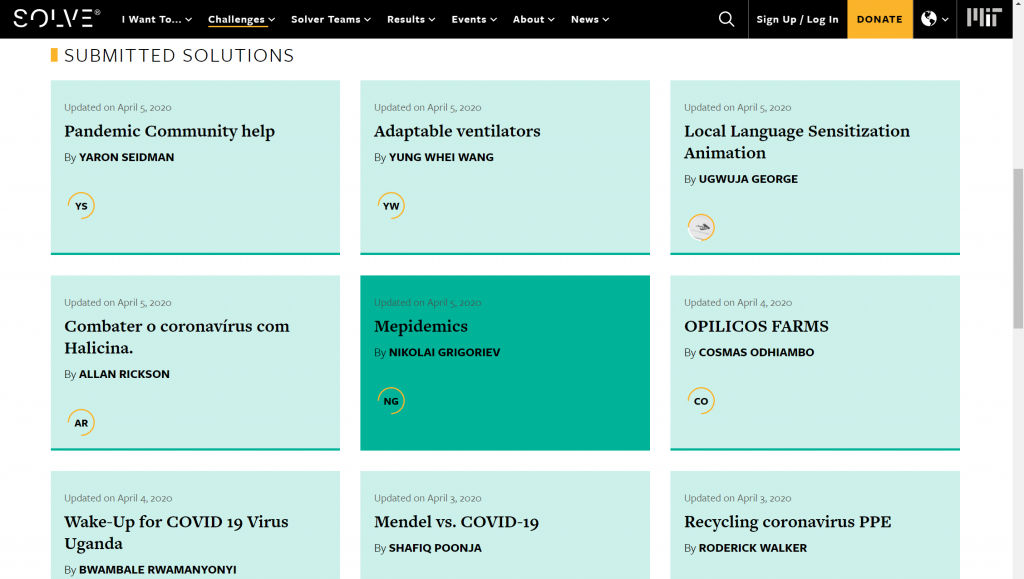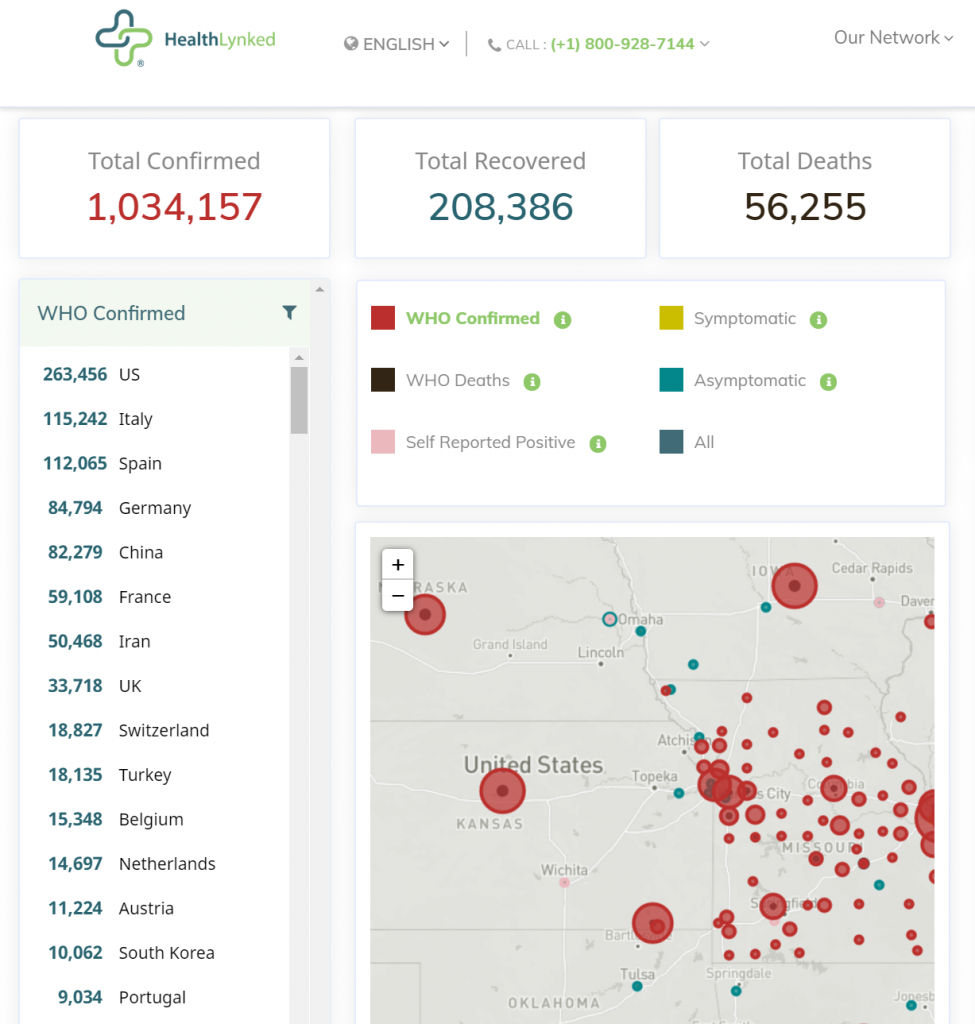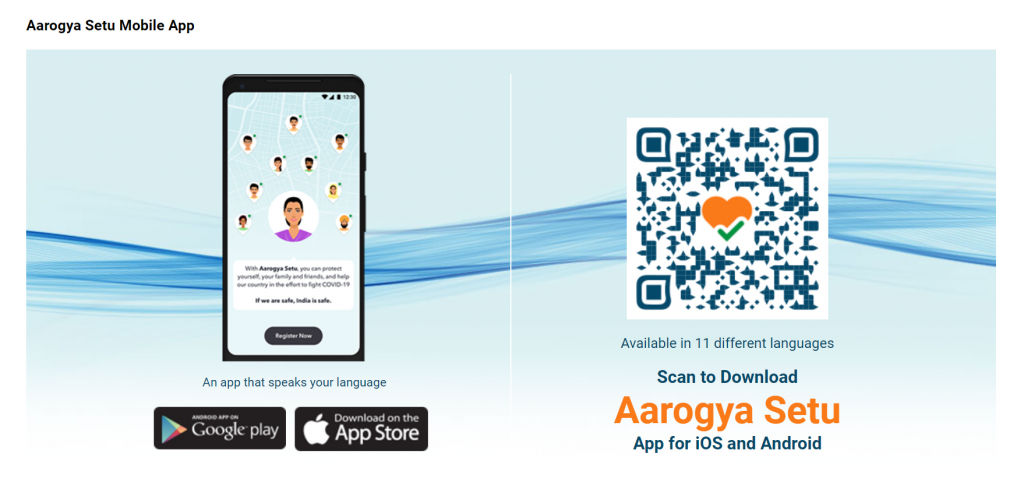Positive use cases of technology bringing different forms of blessings in distress

Introduction
Who would have thought that one day the world will be living in a state of lockdown, where one must step out only if the need is to secure essential commodities and/or visit a doctor. The human race is facing a pandemic, the one which can be characterized as the largest for this generation to encounter.
According to worldometers on 13th April’20, the world has 1,858,699 Coronavirus cases with 114,698 deaths and 429,019 recoveries.
While it affects the human body, the rippling effects are seen on global economies, politics, and cultural beliefs. Judicious, yet impactful decisions by the healthcare systems, governments, and people will define the future years for the world. Whether the path taken is right or not, we are currently living in the chaotic diaspora of Covid-19 (Coronavirus). Amidst this crisis, the profound role technology is playing has started to become the shining armor in this despair.
Since the world began witnessing a global health crisis, there is a tremendous effort to fight the virus efficiently. While the development, testing, and viability of medicine to treat the virus would traditionally take 12-18 months, the advancements in technology can accelerate the process.
Big technology giants, major health research institutes, and governments are relentlessly working to ensure the cure or relief is brought to the table sooner than expected.
Additionally, there is a string of technological innovations/start-ups supporting the battle against the virus. These span from telehealth to awareness-based apps to patient-tracking mechanisms.
In this article, the technological innovations are bucketed in four categories as seen in figure 1 below. Each category discusses the different technologies, companies, activities currently under in motion to fight against the novel coronavirus. As Bill Gates states in his Ted Connect talk, the innovations we do today will make us well prepared to face a pandemic of this magnitude in the future, efficiently.
Figure 1: 4 Categories of Technological Innovations to Fight Covid-19

1. Solution incubators
Democratizing data to continually identify solutions is the need of the hour to fight the pandemic. As a result, a majority of research institutes, government bodies are now sharing vast amounts of data collected in past decades with technology companies to learn, understand, and develop solutions―solution incubators.
“We have a unique opportunity before us to apply the new sciences of AI and digital transformation to learn from these data how we can better manage these phenomena and avert the worst outcomes for humanity,” – Condoleezza Rice, former US Secretary of State.
To begin with, the US White House and a coalition of research groups namely: Allen Institute of Artificial Intelligence, CZI, MSR, National Library of Medicine, National Institute of Health, and Microsoft have prepared a “Covid-19 Open Research Dataset – Cord 19.” CORD-19 is a resource of over 45,000 scholarly articles, including over 33,000 with full text, about COVID-19, SARS-CoV-2, and related coronaviruses. This data is made freely available in an Artificial Intelligence (AI) challenge “Kaggle Challenge.” This challenge asks AI experts across the globe to apply natural language processing and AI techniques to find answers to questions within, and connect insights across, this content in support of the ongoing COVID-19 response efforts, as stated in the Semantic Scholar website.
Next, epidemiological data from the COVID-19 outbreak, real-time case information. This dataset gathers information from national, provincial and municipal health reports, along with additional knowledge from online reports. This information pertains to individuals contracted with Coronavirus including, symptoms, date of contraction, admission, and confirmation and travel records if available. This information is freely available for developers to create patient-tracking applications or create training AI-algorithms.
To create an organized way to support AI innovations, C3.ai, Microsoft Corporation, the University of Illinois at Urbana-Champaign; the University of California, Berkeley; Princeton University; the University of Chicago; the Massachusetts Institute of Technology; and Carnegie Mellon University form a consortium named C3.ai Digital Transformation Institute. The consortium invites AI-based solution in multiple categories, such as:
- Genome-specific COVID-19 medical protocols, including precision medicine of host responses
- Biomedical informatics methods for drug design and repurposing
- Design and sharing of clinical trials for collecting and analyzing data on medications, therapies, and interventions
- Modeling, simulation, prediction of COVID-19 propagation and efficacy of interventions
- Logistics and optimization analysis for the design of public health strategies and interventions
- Rigorous approaches to designing sampling and testing strategies
- Data analytics for COVID-19 research harnessing private and sensitive data, including the role of edge computing/IoT for gathering data
“The C3.ai Digital Transformation Institute, with its vision of cross-institutional and multi-disciplinary collaboration, represents an exciting model to help accelerate innovation in this important new field of study,” said Robert J. Jones, Chancellor of the University of Illinois at Urbana-Champaign. “At this time of a global health crisis, the Institute’s initial research focus will be on applying AI to mitigate the COVID-19 pandemic and to learn from it how to protect the world from future pandemics. C3.ai DTI is an important addition to the world’s fight against this disease and a powerful new resource in developing solutions to all societal challenges.”
Another such consortium is formed by IBM, Amazon Web Services, Google Cloud, Microsoft, Hewlett Packard Enterprise, Massachusetts Institute of Technology, Rensselaer Polytechnic Institute, University of California, Department of Energy National Laboratories, Argonne National Laboratory, Lawrence Livermore National Laboratory, Los Alamos National Laboratory, Oak Ridge National Laboratory, National Energy Research Scientific Computing Center, NASA, and a few more named The COVID-19 High-Performance Computing (HPC) Consortium. The consortium aims at addressing the massive need for computational capacity to help Covid-19 researchers execute complex computational research programs that help combat the virus. As stated on the consortium’s website, researchers are invited to submit COVID-19 related research proposals to the consortium via this online portal, which will then be reviewed for matching with computing resources from one of the partner institutions.
While consortiums are being created, there are multiple hackathons or covidathons organized such as MIT Solve, Devpost hackathon (COVID-19 Global Hackathon), and Decentralized AI Alliance (online hackathon for decentralized AI community).
Figure 2: MIT Solve COVID 19 Challenge Solution Submissions (excerpt)

Source: MIT Solve
In addition to this, there are similar solution incubation efforts done by Google and Twitter. For instance, Google has created a public datasets program, Google’s BigQuery Public Datasets Program to make data more accessible to researchers, data scientists and analysts. In addition to this, Google’s DeepMind, an AI, predictive analytics research organization is focused on creating a structure prediction system to study the SARS-CoV-2 spike protein structure. On the other hand, Twitter is creating a Covid 19 Tweet ID database that collects millions of tweets associated with the coronavirus outbreak and the COVID-19 disease.
Advice: With the outset of an enormous volume of data for training, creating effective AI models, it is essential to address the anomalies that may exist in the dataset. This will reduce the chances of:
a) Extreme unviable results
b) Unforeseen errors
c) Data biases
d) Low accuracy scores
2. Government-run technology applications
Amidst this pandemic, even the non-technological savvy governments are realizing the potential of it to merely spread the awareness of the disease, while tracking the active and potential patients of coronavirus―government-run technology applications.
Majority of the government-run technology applications are aiming at the concept of “smart testing” through identifying and tracking citizens. Smart testing, as stated by Danielle Allen (Harvard Professor), help countries efficiently flatten the curve by increasingly locating the symptomatic and asymptomatic (ones who have come in contact with +ve person but does not show any signs of contraction) individuals, while ensuring the required medical assistance.
Developed economies such as the United States have HealthLynked, which aims to provide continuously updated coronavirus information following the World Health Organization (WHO) data as shown in figure 3.
Figure 3: An excerpt from HealthLynked application

Source: HealthLynked
Vietnam, sharing borders with China, is the fastest reactor toward fighting the Covid-19 battle. The Vietnamese government realized its citizen’s strong reliance on social media and technology apps can help spread community awareness about the disease, while building trust in the government’s efforts (figure 4). Restricting not just to awareness and tracking application, the government supports incentive-based awareness online games, named MochaIQ―a game to broaden and test citizen’s knowledge on the virus.
Figure 4: An excerpt from Appota’s Lich Nhu Y mobile calendar featuring application

Source: Lich Nhu Y app allows user to track updates of Coronavirus in real-time
Similar to the above, India is a great example of “late adopters to front runners” with the launch of Aarogya Setu application (figure 5) for both Andriod and iOS users. The application helps in scouting whether an individual is at the risk of contracting the novel virus on the pretext that he/she has previously encountered a positive covid-19 person. The application functions on the government database of infected individuals, while aiming at proactively informing the citizens of Covid-19 best practices.
Figure 5: An excerpt from Aarogya Setu application

Source: Mygov.in
More examples of such applications are Singapore’s TraceTogether and Brazil’s Coronavirus SUS.
WhileIsrael has Hamagen to track and monitor its citizen, Prime Minister Benjamin Netanyahu is expected to use anti-terrorism tracking technology to spot affected individuals.
The prime minister states– “We will very soon begin using technology… digital means that we have been using in order to fight terrorism.”
Apart from these tracking and awareness building applications, the Hong Kong government rolled out electronic wristband synced to StayHomeStaySafe application, which alerts the authorities if an individual tries to escape from their compulsory home quarantines.
Like this, South Korea’s government has Self Quarantine Safety Protection application, which allows the quarantined individuals to stay in touch with their caseworkers. Whereas, it also uses GPS to keep track of their location to make sure they are not breaking quarantines.
Moreover, Malaysia’s ministry of health established virtual health portal DoctoronCall to help address the Covid 19 risk communication needs.
3. Enablers
Amidst the variety of innovative solutions in its creation process, there are technology companies ramping-up services, identifying gaps to help in these turbulent times―enablers.
To begin with, BlueDot uses big data analytics, natural language processing (NLP), and machine learning technologies to correctly identify the cities connected with Wuhan for anticipated infected areas. Based on the airline ticketing data, BlueDot was able to deliver insights on 11 cities to be highly affected by the coronavirus.
The most common in this category are the health tech companies, such as Biofurmis―creates an AI-powered biosensor attached to a patient’s arm to support doctors and medical staff with Covid-19 diagnosis.
Then, AliveCor―an AI-enabled platform that helps detect sudden cardiac arrests in Covid-19 patients.
Another interesting example is CLEW―an AI and predictive analytics enabled tool enabling insights for doctors and medical staff to assess the patient’s progress from a cough to hospitalization, deteriorate to ICU admission, or develop a need for mechanical ventilation.
While the above companies help the frontline health workers, some applications support individuals with home healthcare assistance. For instance, ManaDr―an application that helps in teleconsultations to avoid face-to-face clinic visits and hence minimize their risks of exposure to Covid-19.
Similar to this, Tyto Care―bridges thegap betweenpeople, physicians, and health systems, enabling everyone, especially symptomatic patients, to stay at home and communicate with physicians through virtual channels, helping to reduce the spread of the virus to mass populations and the medical staff on the frontlines, as stated by its CEO Dedi Gilad.
Interestingly, famously known PingAn Good Doctor App, China’s largest telehealth platform witnessed a jump of 1186% in downloads to seek virtual health assistance for Covid-19 in Jan’20.
On the other hand, KlinicApp, an e-diagnostic start-up is enabling home-testing of suspected Covid-19 patients based on consulted doctor’s prescription.
Although interesting and informative, applications such as MIT Media Lab’s Private Kit: Safe Paths and USC Institute of Creative Technologies’ battle buddy tracks personal data to identify and screen suspected and contracted Covid-19 patients. Whereas, the battle buddy can also help medical staff with insights into a patient’s recovery or answer the patient’s questions.
Another state-of-the-art innovation is made by BlinkIN―a video application platform using augmented reality to bring knowledge on the user’s device was able to help Huber & Ranner (a German manufacturer of air-handling units) for installing air ventilation in two Wuhan (epicenter of Covid-19) hospitals.
“BlinkIN offers ‘Scotty’ an artificial intelligence (AI) and augmented reality (AR)-powered live video calling system. The agent can handhold users and guides them using augmented on-screen annotations and live pointers overlaid on their screen.” Dhiraj Choudhary, Cofounder BlinkIN
DronaMaps, a start-up using AI to track patient movement and create a live dashboard with features such as location tracking, geofencing, and predictive analytics.
“To flatten the curve of the number of cases with the disease, it is important to track the positive cases, suspected cases, quarantined individuals, hospitalized cases, etc. To give an example, all suspected cases are constantly monitored through social media or VLR (call records). This ensures officials are aware of the places they could have visited and by detecting the mobile phones close to the patient’s phone, the people who have been in close physical proximity with the patient.” – Utkarsh Singh, Cofounder DronaMaps
In addition to the above enablers, there are many solution providers such as Vital, Dozee, Qure.ai, log9, Mylabs, Stanplus, and biodesign innovation labs who are performing exemplary work in fighting against Covid-19 through technology.
4. Platform-as-a-service
In the times where AI, machine learning, natural language processing, deep learning technologies are extensively encouraged and supported to use for creating, training, and testing solutions, the infrastructure services can lead to extreme cost expenditures. But, in these times of existential crisis, multiple organizations are providing its technological infrastructure with no fee attached to it―platform-as-a-service.
Recognizing the widespread need to apply AI for genomic studies, Core Scientific is providing 30-day free access to its ONTAP AI platform, which helps researchers take advantage of NVIDIA Parabricks including NetApp’s cloud for flash storage to conduct Covid-19 related research.
“These are times where we need to maximize the insights from data through the use of data science and AI. We are putting the power of NetApp AI into the hands of those who require GPU accelerated compute and data, in the form of a turnkey platform for AI Training and Inferencing to accelerate their research,” said Santosh Rao, Senior Technical Director, AI & Data Engineering, NetApp.
Similar to the above initiative, DataRobot is offering its AI platform for free which is also being used in the aforementioned Kaggle challenge. Moreover, RunAI provides free deep learning model software to create virtualization layers for genomics studies.
Further, DarwinAI is working with the University of Waterloo’s VIP lab for developing COVID-Net (figure 6), a convolutional neural network to study chest radiography and detect Covid-19 patients.
Figure 6: Example of chest radiography images of Covid-19 cases from 2 different patients

Source: COVID-Net: an open-source neural network for COVID-19 detection
While the above use cases contribute towards studying the virus, Jumio, a California-based payments company is offering an AI-powered tool Jumio Go for remote user verification service free of cost to telehealth professionals trying to diagnose patients remotely.
“Organisations involved in relief and assistance during this crisis have an urgent need to be able to quickly and accurately ‘identity proof’ their patients, students, and workers to ensure critical services can be delivered and trusted,” as stated on Jumio’s website.
Neo4j, a graph data platform providing free access to data scientists, developers, researchers working on Covid-19 projects (figure 7).
Figure 7: Neo4j’s interactive visualization graph to study Covid-19 cases

Source: Tracking SARS-CoV-2 genetic drift across migration patterns
Facebook is partnering with its pre-existing developer community to support scalable response by the government health organizations about Covid-19. In addition to this, the social media technology giant is providing Facebook Messenger services for free to UNICEF and Pakistan for sharing advisory information about the pandemic.
To support data scientists, technology developers, and public health professionals, IBM’s blockchain platform is supporting data streaming services for the MiPasa project. The project synthesizes data sources, addresses inconsistencies, and helps identify errors and misreporting to ensure accurate information is provided for creating credible solutions for the outbreak.
In a mass reach-out effort, WHO, UNICEF, and UNDP collaborate with WhatsApp to deliver real-time information regarding the Covid-19 called the WhatsApp Corona Virus Information Hub.
Conclusion
There is continuous battle humanity is facing today, a health war―choking the lives out of acutely infected people, while making it no easy for others. This is an unprecedented battle, but what makes it easier to win is that the world stands in unity. We have remarkable instances in the past when the world has come together, for example the “global recession 2008.” There was a united effort to revive economies across the globe, and quickly stem out the inefficiencies and loopholes that led to it. The world has also witnessed the “Spanish flu,” affecting 500 million with a mortality rate of 20%, however, it brought the world together in the times of lethal world war I (1918-1920), bringing enemies together in the name of humanity.
In today’s scenario, with the unity effort, this travesty on humankind is witnessing the greatest innovations in technology to win the battle against Covid-19. Where such technological strides would pop-up in silos and take years to make a widespread impact has now become a compelling force to innovate. If not today, we are better prepared to handle tomorrow and the future. The Covid-19 pandemic is making the world a more conscious, aware society than it previously existed through technology.
What opportunities does the Covid-19 pandemic leave for mankind in the future?
End notes
http://blog.netapp.com/covid-19-research-support
https://vitaler.com/clinicians
https://www.technologyreview.com/s/615372/coronavirus-infection-tests-app-pandemic-location-privacy
https://www.healthcareitnews.com/news/telemedicine-during-covid-19-benefits-limitations-burdens-adaptationps://www.forbes.com/sites/tomtaulli/2020/03/28/ai-artificial-intelligence-companies-that-are-combating-the-covid-19-pandemic/#637abee758f8
https://doi.org/10.5281/zenodo.3727291
https://doi.org/10.1016/S1473-3099(20)30120-1
https://doi.org/10.1038/s41597-020-0448-0
https://towardsdatascience.com/5-datasets-about-covid-19-you-can-use-right-now-46307b1406a
https://solve.mit.edu/challenges/health-security-pandemics/solutions#challenge-subnav-offset
https://www.ibm.com/covid19/hpc-consortium